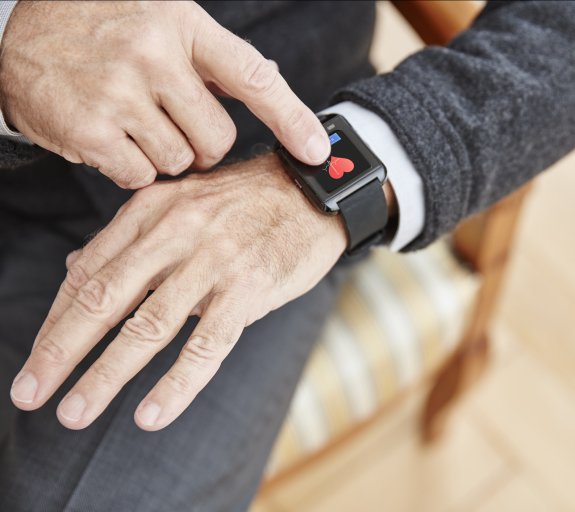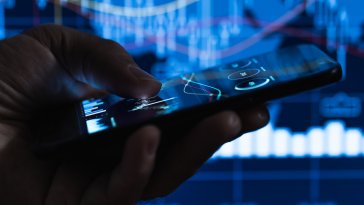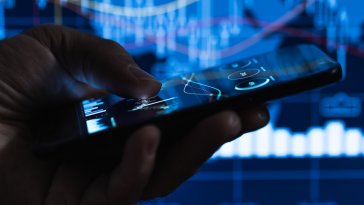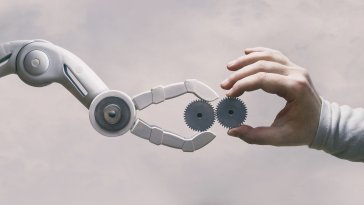
Innovation in personal health technology signals investment opportunities
Wearables and personal health technology are improving rapidly and gaining popularity, signaling investor potential.
From fitness watches to continuous glucose monitors, U.S. consumers are turning to the latest in wearable wellness and personal health products, many powered by AI innovations.
Demand rose sharply during the COVID-19 pandemic1 as people sought self-care solutions. The number of U.S. consumers prioritizing wellness continued to grow, from 42% in 2020 to 50% in 2022.2 Meanwhile, as the U.S. population ages, many older consumers use personal medical devices to manage conditions.
Global trends underscore potential investment opportunities, as the fitness tracker market has a projected CAGR of 19.1% between 2023 and 20303, and the patient monitoring device market could grow 7.7% during that period.4
- {https://www.mpo-mag.com/contents/view_breaking-news/2022-08-11/chronic-infectious-disease-prevalence-to-benefit-vital-signs-monitoring-market/;Medical Product Outsourcing (8/11/2022): Chronic, Infectious Disease Prevalence to Benefit Vital Signs Monitoring Market}
- {https://www.mckinsey.com/industries/consumer-packaged-goods/our-insights/still-feeling-good-the-us-wellness-market-continues-to-boom;McKinsey & Company (9/19/2022): Still feeling good: The US wellness market continues to boom}
- {https://www.fortunebusinessinsights.com/fitness-tracker-market-103358;Fortune Business Insights (10/2023): Fitness Tracker Market}
- {https://www.grandviewresearch.com/industry-analysis/patient-monitoring-devices-market;Grand View Research (n.d.): Patient Monitoring Devices Market Size, Share & Trend Analysis Report By Product, By End-Use (Hospitals, Ambulatory Surgery Centers, Home Care Settings, Other End Users), By Region, And Segment Forecasts, 2023 - 2030}
The longevity economy and AI are two notable growth drivers
An aging patient population is driving demand for personal health tech. Baby Boomers are a significant consumer demographic, with seniors living longer than ever. Today, retired 65-year-old couples in the U.S. can pay close to $275,000 in out-of-pocket healthcare expenses.5 These consumers are likely to spend on personal health tech designed to improve longevity and condition management.
Artificial intelligence is transforming healthcare, enabling robotic surgeries,6 powering faster diagnoses7– and now powering next-generation wearables. Since AI enables predictive analytics and deep analysis, it allows for real-time pattern analysis, correlation to clinical problems, and personalized insights, helping consumers optimize their health. Investors may see a burgeoning opportunity in this tech-driven health and wellness space.
An investor’s look at personal wellness wearables
For years, “personal wearables” just meant “step trackers.” No longer. Wearables can track all manner of interesting biometric data, and user experiences have improved, too, with gamification elements and feedback loops encouraging users to stay active, maintain nutrition, and manage stress.
No wonder that in the third quarter of 2023 alone, 150 million wearables were shipped worldwide.8The global fitness tracker market has a projected 19.1% CAGR between 2023-2030, with North America taking a 48% market share.9
Top tech market leaders have heavily invested in wearables. Apple led the wearables market in 2022 with a 29.7% share,10 launching the latest Apple Watch that can track heart rate, blood oxygen, respiratory rate, sleep, and more.11 Alphabet, Inc. (Google) acquired Fitbit in 2021, further diversifying its business ventures.12 Fitbit now powers the Google Pixel Watch, and product development continues with an upcoming AI person trainer feature.13 Meanwhile, Samsung – which saw a 10-fold rise in Q1 2024 profits14 – is catching up in health tech with its Galaxy Ring health tracker expected later this year.15
Beyond the tech leaders, many other companies focusing on personal wellness wearables – and watches or wristbands aren’t the only product options.
- Garmin: Garmin’s products offer stress tracking, sleep analysis, heart rate monitoring, respiration details, and more.16 The company’s fitness segment saw a 22% bump in revenue in Q4 of 2023 and expects a 10% increase in 2024, while their stock beat predictions for Q4 2023.17
- Whoop: Valued at $3.6 billion,18 this subscription-based fitness tracker company has seen private investments from high-profile athletes.
- Oura Ring: This ring monitors over 20 biometrics, notably excelling in sleep tracking.19 Oura dominated the smart ring market in 2021 with a 52.69% share,20and recently shifted to a more competitive retail model, including selling through Amazon.21
- NURVV Run: While a small UK-based company, they have demonstrated innovation in the wearables space. NURVV Run’s smart insoles use 16 precision sensors to measure running cadence, pronation, and more to help runners improve their technique.22
- FlexoSense: Singapore start-up FlexoSense has designed smart insoles capable of tracking workplace incidents in real time for industry use,23 demonstrating the potential for corporations to leverage wearables.
By paying attention to the top market players and emerging innovators, investors can understand the competitive landscape and identify potentially promising investment opportunities.
- {https://www.cnbc.com/opt-in-check/?pub_referrer=%2F2017%2F10%2F03%2Fhealth-care-dilemma-10000-boomers-retiring-each-day.html;CNBC (10/3/2017): Health-care dilemma: 10,000 boomers retiring each day}
- {https://www.facs.org/for-medical-professionals/news-publications/news-and-articles/bulletin/2023/june-2023-volume-108-issue-6/ai-is-poised-to-revolutionize-surgery/;American College of Surgeons (6/7/2023): AI Is Poised to “Revolutionize” Surgery}
- {https://linushealth.com/press-releases/blog/digital-clock-drawing-test-can-detect-alzheimers-biomarkers-in-individuals;Linus Health (4/14/2021): Digital Clock Drawing Test Can Detect Alzheimer’s Biomarkers in Individuals with No Symptoms, Study Finds}
- {https://www.statista.com/statistics/435933/quarterly-wearables-shipments-worldwide-by-vendor/;Statista (11/7/2023): Wearables unit shipments worldwide by vendor from 1st quarter 2014 to 3rd quarter 2023}
- {https://www.fortunebusinessinsights.com/fitness-tracker-market-103358;Fortune Business Insights (October 2023): Fitness Tracker Market}
- {https://www.statista.com/statistics/515640/quarterly-wearables-shipments-worldwide-market-share-by-vendor/;Statista (2/13/2024): Market share of wearables unit shipments worldwide from 2014 to 2022, by vendor}
- {https://www.apple.com/healthcare/apple-watch/;Apple (n.d.): Apple Watch. Empowering your patients to live a healthier day.}
- {https://blog.google/products/devices-services/agreement-with-fitbit/;Google (11/1/2019): Helping more people with wearables: Google to acquire Fitbit}
- {https://blog.google/technology/health/google-generative-ai-healthcare/;Google (3/19/2024): Our Progress on Generative AI in Health}
- {https://www.reuters.com/technology/samsung-flags-931-rise-first-quarter-profit-chip-prices-recover-2024-04-04/;Reuters (4/5/2024): Samsung flags 10-fold rise in first-quarter profit as chip prices recover}
- {https://www.cnbc.com/2024/02/26/samsung-galaxy-ring-specs-features-release-date.html;CNBC (2/26/2024): Samsung debuts a ‘smart ring’ with health-tracking features — its first foray into the product category}
- {https://www.garmin.com/en-US/p/1057989;Garmin (n.d.): vívoactive® 5}
- {https://seekingalpha.com/news/4069679-garmin-gains-on-beating-consensus-for-q4-numbers-expects-2024-revenue-to-rise-by-10;Seeking Alpha (2/21/2024): Garmin gains on beating consensus for Q4 numbers, expects 2024 revenue to rise by 10%}
- {https://notice.co/c/whoop;Notice (4/5/2024): Whoop Stock}
- {https://ouraring.com/;Oura Ring (n.d.): Oura Ring}
- {https://www.linkedin.com/pulse/smart-ring-market-2023-structure-along-size;360 Industry Insights (9/20/2023): Smart Ring Market 2023 Structure Along With Size, Trends, Revenue, Segments, Forecast to 2030}
- {https://www.cnbc.com/2024/03/07/oura-to-sell-its-smart-rings-on-amazon.html;CNBC (3/7/2024): Oura to Sell Its Smart Rings on Amazon}
- {https://www.nbcnews.com/select/shopping/nurvv-run-smart-insoles-ncna1269954;NBC News (6/8/2021): NURVV smart insoles: A new form of wearable running tech}
- {https://techxplore.com/news/2023-02-smart-insole-mitigate-workplace-falls.html;TechXplore (2/7/2023): Smart insole to identify and mitigate workplace slips, trips and falls}
An investor’s look at wearable devices for patient monitoring, assistance, and behavior change
Wearable devices go beyond lifestyle – they have a significant role to play in healthcare.
Remote patient monitoring devices send data to healthcare providers for assessment and intervention, allowing professionals to continuously monitor patients’ vital signs, symptoms, and medication adherence while saving time and cutting costs. Remote monitoring can also offer researchers insights into clinical trials and drug trials from afar, lowering costs.24 The remote patient monitoring device market was valued at $25.32 billion in 2020 and could reach $101.02 billion by 2028.25
Patients can also adjust their own behavior based on the data from wearables. For instance, if a continuous glucose monitor (CGM) registers a spike, the patient can take immediate action to lower the number. This kind of real-time feedback loop can be a powerful way to drive healthy behaviors. Top CGM provider DexCom saw significant momentum in 2023 with its G7 product, and recent stock gains could be related to the growing prevalence of GLP-1 users.26
Other personal health devices can track medication intake patterns, send users medication reminders, and notify caregivers of missed doses. If the device detects the user didn’t take their medication, it can inform the wearer and their doctor, potentially preventing a costly complication or hospitalization.
Wearables can also include assistive devices, such as hearing aids or assistive robotics. For example, GaitQ’s Tempo collects gait information and issues vibrational cues to help people with Parkinson’s maintain a fluid, stable gait.27Other companies are creating “exoskeletons,” or wearable suits with motorized joints, to protect construction workers28– taking the concept of wearables to the next level.
Some insurance companies, like UnitedHealthcare,29are encouraging beneficiaries to use wearables, a strategy that could help lower claims costs and improve investor potential.
Personal health wearables are a potentially lucrative frontier for investors
As the technology continues to evolve, consumer demand for wearable health devices is likely to remain high, especially for older consumers and those addressing health conditions. These devices offer financial benefits for the healthcare system and insurance companies, too. Investors who recognize the growing significance of personal healthcare technology stand to support the rise of an important and lucrative industry.
- {https://www.ncbi.nlm.nih.gov/pmc/articles/PMC10337412/;National Library of Medicine: National Center for Biotechnology Information (6/27/2023): Reducing Clinical Trial Monitoring Resources and Costs With Remote Monitoring: Retrospective Study Comparing On-Site Versus Hybrid Monitoring}
- {https://www.fortunebusinessinsights.com/remote-patient-monitoring-devices-market-106328;Fortune Business Insights (February 2022): Remote Patient Monitoring Devices Market}
- {https://www.marketbeat.com/stock-ideas/dexcom-stock-gains-from-glp-1-diabetic-users/;MarketBeat (4/2/2024): DexCom Stocks Gain from GLP-1 Diabetic Users}
- {https://www.gaitq.com/product/tempo/;GaitQ (n.d.): Tempo}
- {https://www.captechu.edu/blog/exoskeletons-promising-development-construction-site-safety;Capitol Technology University (8/8/2022): Exoskeletons: A promising development for construction site safety}
- {https://unitedhealthcaremotion.com/;UnitedHealthcare (n.d.) UnitedHealthcare Motion}
Companies shown are for illustrative purposes only. It does not constitute investment research or financial analysis relating to transactions in financial instruments, nor does it constitute an offer to buy or sell any investments.
Risk Warning:
Investment involves risk including the loss of capital.
The information has been established on the basis of data, projections, forecasts, anticipations and hypothesis which are subjective. This analysis and conclusions are the expression of an opinion, based on available data at a specific date. Due to the subjective aspect of these analyses, the effective evolution of the economic variables and values of the financial markets could be significantly different for the projections, forecast, anticipations and hypothesis which are communicated in this material.
Disclaimer
This document is being provided for informational purposes only. The information contained herein is confidential and is intended solely for the person to which it has been delivered. It may not be reproduced or transmitted, in whole or in part, by any means, to third parties without the prior consent of the AXA Investment Managers US, Inc. (the “Adviser”). This communication does not constitute on the part of AXA Investment Managers a solicitation or investment, legal or tax advice. Due to its simplification, this document is partial and opinions, estimates and forecasts herein are subjective and subject to change without notice. There is no guarantee forecasts made will come to pass. Data, figures, declarations, analysis, predictions and other information in this document is provided based on our state of knowledge at the time of creation of this document. Whilst every care is taken, no representation or warranty (including liability towards third parties), express or implied, is made as to the accuracy, reliability or completeness of the information contained herein. Reliance upon information in this material is at the sole discretion of the recipient. This material does not contain sufficient information to support an investment decision.
© 2024 AXA Investment Managers. All rights reserved.





